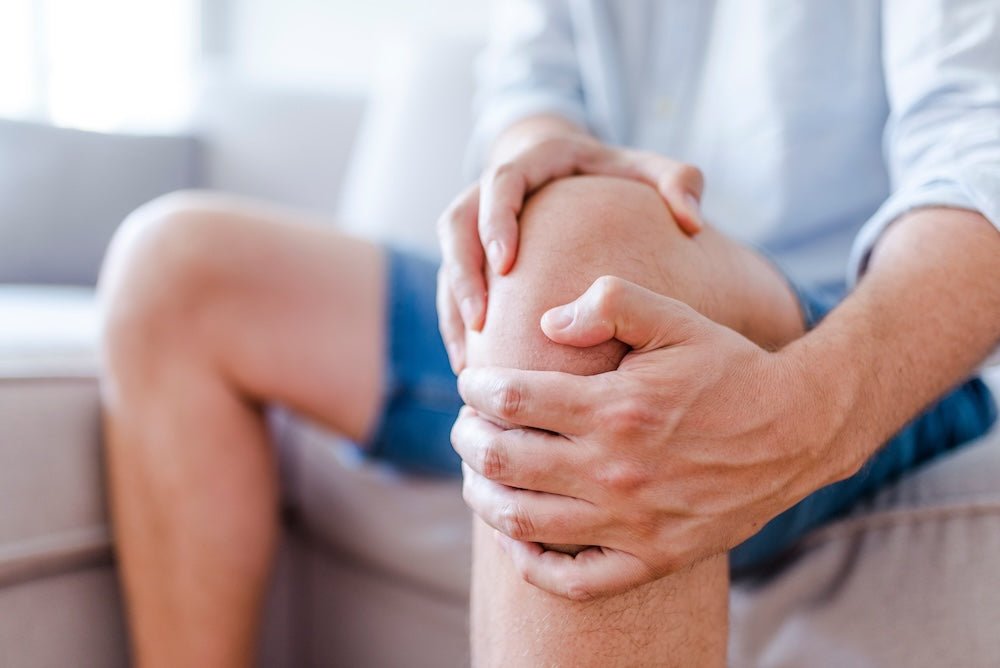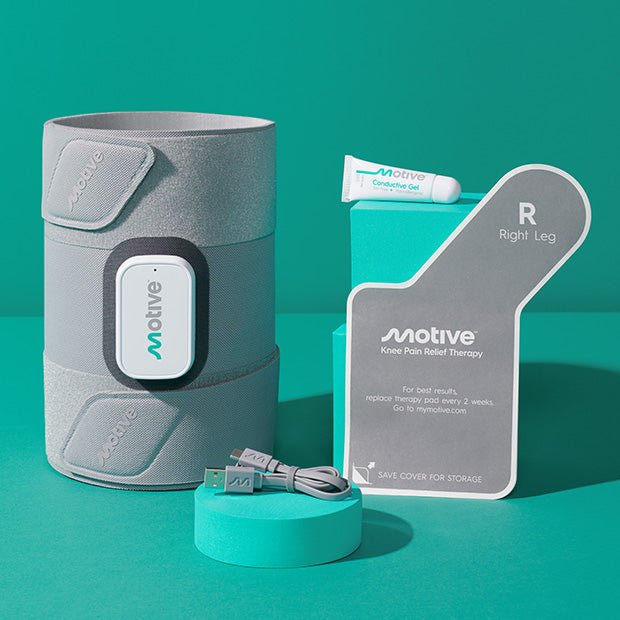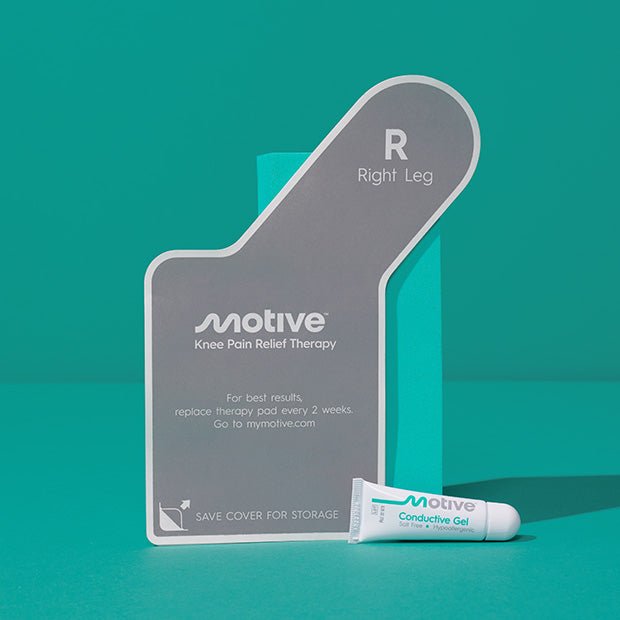
When your knee swells, it's a signal from your body that something is wrong, be it an injury, overuse, or an underlying condition. This swelling, known as "knee effusion," is more than just discomfort—it can cause you to lose your freedom to move effortlessly. Being restricted every time you try to bend or straighten your knee is no way to live life.
Learn more below on other symptoms that can accompany knee swelling and pain, as well as how medical professionals diagnose and treat knee injuries.
The Anatomy of the Knee
The knee joint, one of the largest and most weight-bearing joints in our body, consists of three bones:
- Femur (thigh bone)
- Tibia (shin bone)
- Patella (kneecap)
At the heart of the knee sits the patella within the quadriceps muscle, lined with thick cartilage built to endure the pressures of our daily endeavors. The other parts of the knee joint are cartilage acting as shock absorbers, ligaments providing stability, tendons also aiding in stability, quadriceps and hamstring muscles that help flex the knee joint, and bursa, a fluid-filled sac that prevents friction between two bones.
Yet, when any of these components suffer—be it from an injury, a strain, or wear and tear—the harmony is disrupted, which leads to severe pain, and in some cases, swelling, transforming simple actions into challenging feats. Conditions like bursitis, tendinitis, and patellofemoral pain syndrome (PFPS) are not just medical terms; they represent a battle against discomfort, a struggle to reclaim the effortless movement once taken for granted.
Figure: Different parts of the knee joint.
Common Causes of Knee Swelling and Pain
Understanding the common causes of knee swelling and pain it is crucial to identify potential issues early, seek appropriate care, and make informed decisions about your health and mobility. Below are some of the most common causes of knee swelling and pain.
Knee arthritis is a daily battle with stiffness and pain. Osteoarthritis occurs when the cartilage wears away, leading to swelling and a deep, aching pain. Treatments like physical therapy and corticosteroid injections can ease the relentless discomfort.
Rheumatoid arthritis, on the other hand, is an autoimmune disorder that attacks your knee lining, causing swelling, redness, and tender stiffness.
Physical trauma, whether from sports, accidents, or simple missteps, are examples of knee injuries. Whether in the bursa, ligament, meniscus, or articular cartilage, the injury leads to swelling and pain in the knee joint. Significant swelling, warmth, stiffness, and bruising in the knee joint may indicate a serious injury, known as hemarthrosis, which requires immediate medical attention and consultation from an orthopedic surgeon. Other more common injuries observed in people are meniscus tear and anterior cruciate ligament (ACL) and medial collateral ligament (MCL) injuries.
The repetitive motion and overuse of the knee can lead to acute injuries like sprain tendonitis and torn ligaments. This often leads to swelling in the area, accompanied by severe pain and redness. Resting, wearing braces, or medication may help with such knee health conditions. In the case of severe damage, however, specialists may recommend surgery.
If bacteria invade the synovial fluid that lubricates your knee joint, it can lead to an infection known as a septic joint. In this condition, symptoms such as chills, nausea, and high fever with severe knee pain and swelling will appear. Healthcare providers may recommend an antibiotic treatment or surgery to treat the condition.
Symptoms Accompanying Swelling and Pain
Swelling in the knee is often accompanied with other symptoms, such as:
- Swelling in the area around the kneecap.
- Stiffness in the knee, causing the inability to bend or straighten your legs.
- Severe pain while lifting anything heavy.
- Redness or discoloration in the affected area.
Diagnosing the Underlying Cause
The diagnosis of a swollen knee begins with a detailed history and physical examination. Your health care provider or orthopedic surgeon will ask you questions regarding the issue, like when you noticed swelling, the intensity of the pain, any prior knee injuries, family history of autoimmune disease, etc. Through various tools and range of motion exercises, they will examine the swollen knee’s condition. However, they may perform other imaging and lab tests to understand the cause of the knee problem.
The three types of imaging tests used in assessing knee problems are:
- X-ray: It effectively detects arthritis or any bone dislocation or fractures.
- MRI: Any soft tissue, tendon, and ligament injuries within the knee not detected by X-ray are caught in MRI scans through radio waves and a strong magnetic field.
- Ultrasound: It detects problems in tendons and ligaments using sound waves.
Furthermore, blood tests (arthrocentesis) are also performed to detect any infection, inflammation, or diseases like gout (a painful form of arthritis caused by the formation of uric acid crystals in the knee) or pseudogout.
Treatment and Management Strategies
Medical professionals will treat a swollen knee based on the diagnosis, the severity of swelling and knee pain, and any medical history.
With the RICE technique, you can manage your mild swollen knee and pain on your own. It stands for:
- Rest: Do not overstress your knee by doing extensive weight-bearing activities. Give it some rest!
- Ice: Apply an ice pack on the affected area for about 15-20 minutes every 2-4 hours.
- Compression: Using an elastic bandage to wrap your knee can assist in managing swelling.
- Elevation: Elevating your knee above the level of your heart with cushions adds extra comfort to your knee pain.
Consider taking over-the-counter non-steroidal anti-inflammatory drugs (NSAIDs) and pain-relieving medications like acetaminophen (Tylenol, others) or ibuprofen (Advil, Motrin IB, others) to help ease knee pain.
It helps improve knee functions by strengthening knee muscles. Exercises that can relieve pain include straight leg raises/lifts, standing hamstring curls, squats, standing knee lifts, and inner thigh stretches.
Many surgical options are available today that are performed by orthopedic surgeons when necessary.
- Arthroscopy: In this procedure, a small incision is made in the knee, and a small tube with some attached tools is inserted through it to repair any knee damage or remove loose tissue.
- Arthroplasty (Knee replacement): In this process, the orthopedic surgeon replaces damaged parts of your knee joint with a prosthesis made of plastic or metal.
Another effective approach to treating knee pain is Motive therapy. It’s an FDA-cleared and physician-recommended therapy that targets one of the root causes of knee pain, muscle weakness, without the inconvenience of doctors' appointments and prescriptions. It strengthens muscles around your knee joint, providing lasting knee pain relief.
Get Back on Your Feet with Motive
When knee swelling and pain enter your life, they bring more than just physical discomfort; this condition, often the aftermath of osteoarthritis, an injury, or an infection, can make each step a challenge.
But Motive Health is here to help. More than just a treatment, this non-invasive approach, praised by physicians and cleared by the FDA, offers long-lasting knee pain relief by addressing muscle weakness, one of the root causes of knee pain. It strengthens the muscles around your knee for more comfort and ease, enabling better movement when regularly used.
Say goodbye to regular doctor’s visits and frequent prescriptions and embrace a fuller, more active life with Motive therapy. Get Motive knee therapy now, and take the first step towards a life where your knees no longer hold you back.




